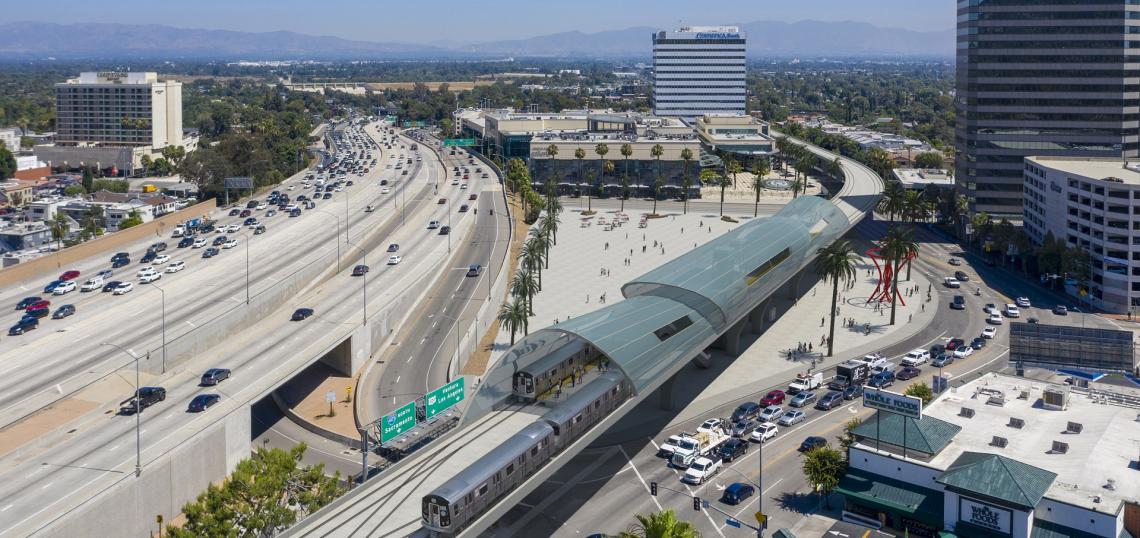Heavy rail or monorail? The debate over which technology should be used for a new rail line connecting the Westside to the Valley continues, as Metro begins the environmental review period for the Sepulveda Transit corridor.
Metro, which is considering building the rail line through a public-private partnership, will study six alternatives in the project's environmental impact report. As detailed in The Source, they include:
Alternative 1
 Alternative 1 - automated monorail on aerial alignment along the I-405 corridor and Metrolink right-of-way, with electric bus shuttle connection to UCLAMetro
Alternative 1 - automated monorail on aerial alignment along the I-405 corridor and Metrolink right-of-way, with electric bus shuttle connection to UCLAMetro
An automated, aerial monorail system running 15.3 miles adjacent to the I-405 freeway between the Van Nuys Metrolink Station and the E Line's Expo/Sepulveda Station, with intermediate stops located at Sherman Way, the G Line's Sepulveda Station, the 405-101 interchange, the Getty Center, Wilshire Boulevard (D Line transfer), and Santa Monica Boulevard.
This option would have capacity for trains of up to eight cars in length, with service running every two minutes during peak hours, and each car carrying a maximum of 79 people. A maintenance and storage facility is proposed next to the G Line's Sepulveda Station, and a connection to UCLA is proposed as a 1.4-mile electric bus shuttle, operating as the same frequency as the monorail.
Alternative 2
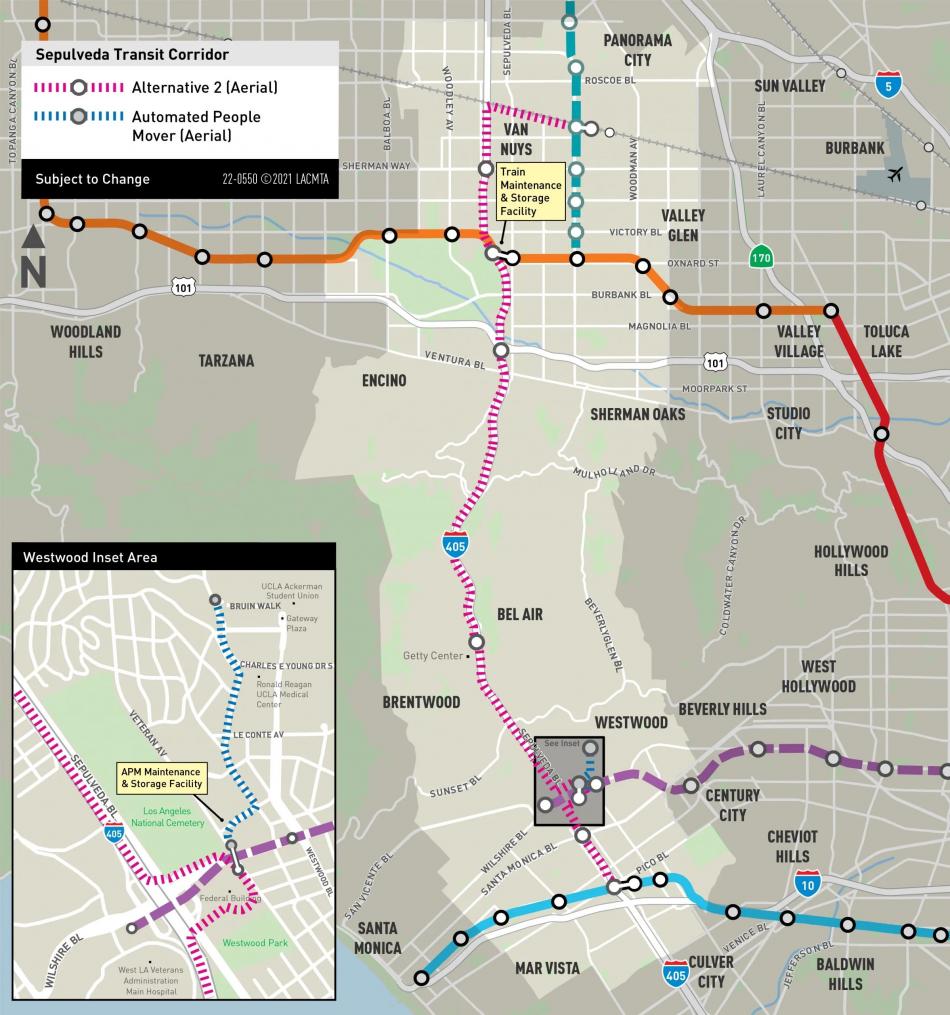 Alternative 2 - automated monorail with aerial alignment along I-405 corridor and Metrolink right-of-way, with automated people mover connecting to UCLAMetro
Alternative 2 - automated monorail with aerial alignment along I-405 corridor and Metrolink right-of-way, with automated people mover connecting to UCLAMetro
A 15.8-mile automated, aerial monorail system running on a similar route to Alternative 1, which would connect to UCLA via an automated people mover in lieu of a shuttle bus.
Alternative 3
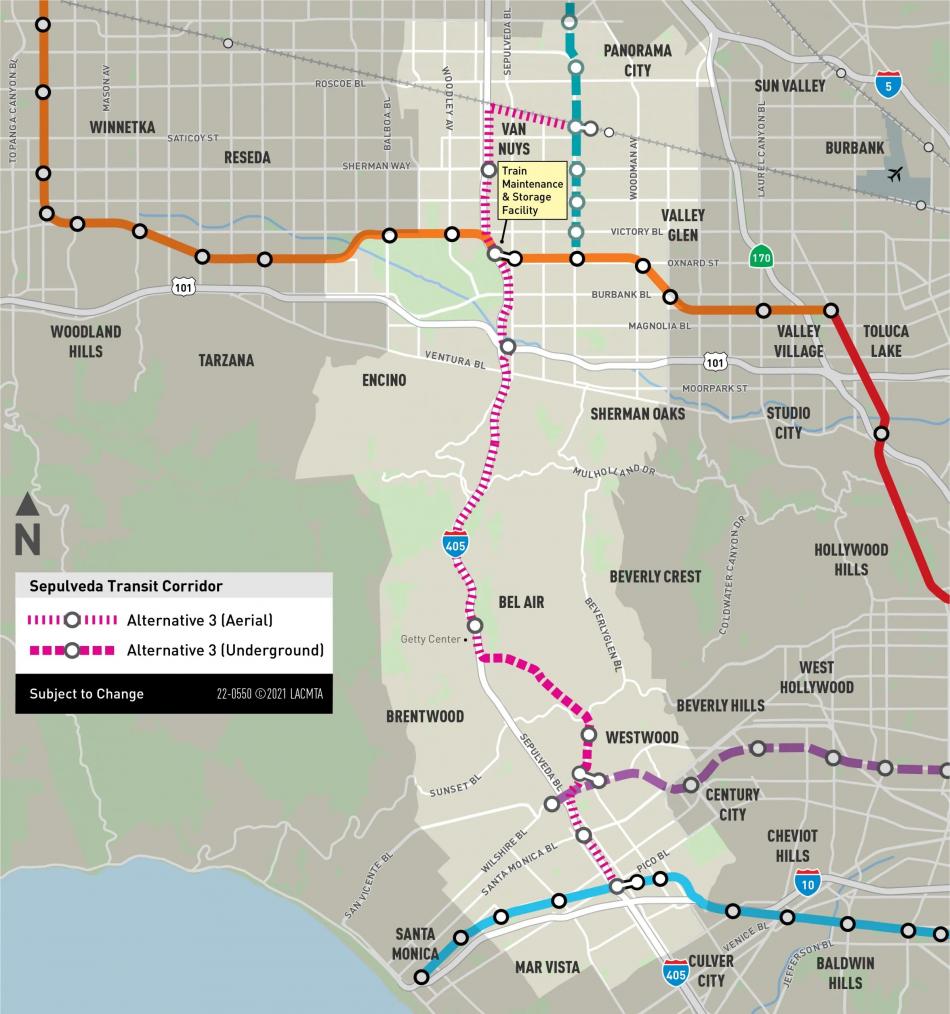 Alternative 3 - automated monorail along I-405 corridor with underground segment between Wilshire Boulevard and the Getty Center, than aerial alignment along the I-405 corridor and Metrolink right-of-way
Metro
Alternative 3 - automated monorail along I-405 corridor with underground segment between Wilshire Boulevard and the Getty Center, than aerial alignment along the I-405 corridor and Metrolink right-of-way
Metro
A 16.2-mile automated monorail system, with varying segments of aerial and below-grade track. Rather than connecting to UCLA through a bus or people mover, a stop would be located at Gateway Plaza near the center of the campus.
Alternative 4
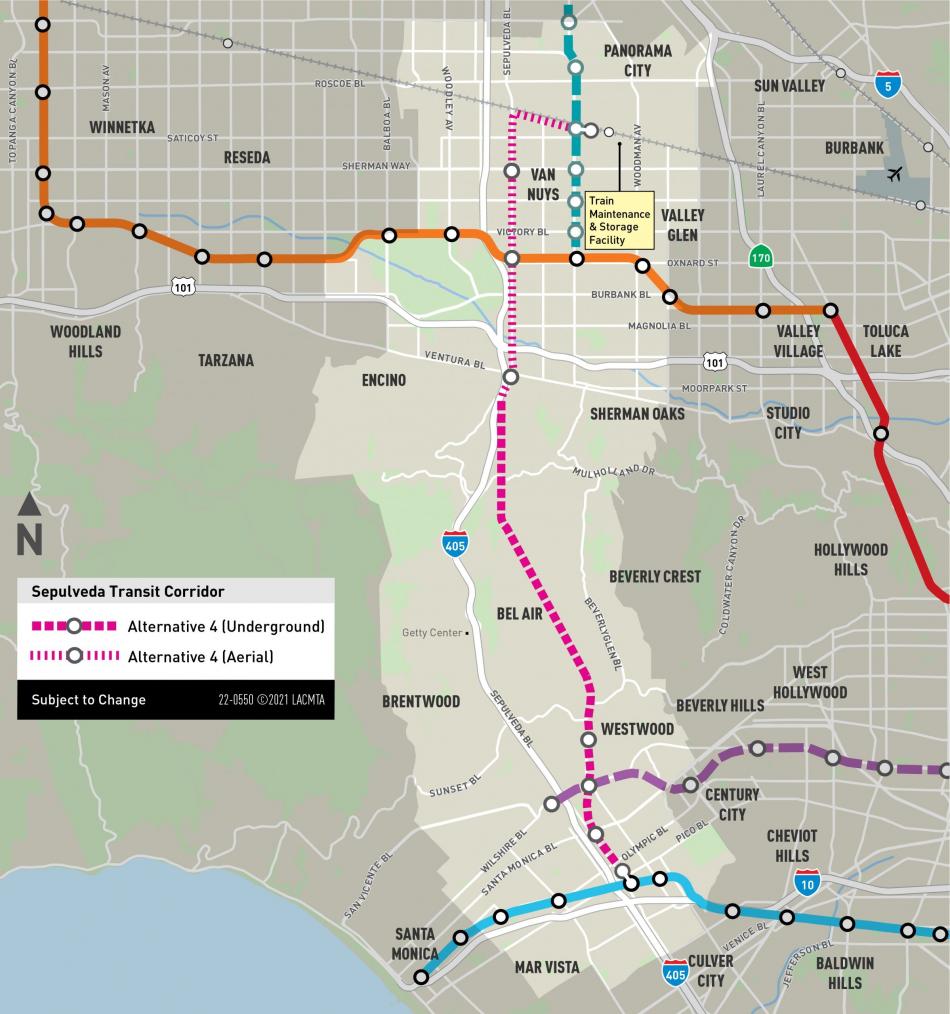 Alternative 4 - heavy rail with underground alignment south of Ventura Boulevard and aerial alignment along Sepulveda Boulevard in the ValleyMetro
Alternative 4 - heavy rail with underground alignment south of Ventura Boulevard and aerial alignment along Sepulveda Boulevard in the ValleyMetro
A heavy rail train running approximately 14 miles, starting at the Van Nuys Metrolink Station in the north and Expo/Sepulveda Station in the south. The alignment would run on aerial structures along the Metrolink right-of-way, then Sepulveda Boulevard, before transitioning to below-grade operations south of Ventura Boulevard. Intermediate stops are proposed at Santa Monica Boulevard, Wilshire Boulevard, UCLA's Gateway Plaza, Ventura Boulevard, the G Line's Sepulveda Station, and Sherman Way.
Trains could run in maximum four-car sets, with each car carrying up to 170 passengers, and peak hour headways of 2.5 minutes.
Alternative 5
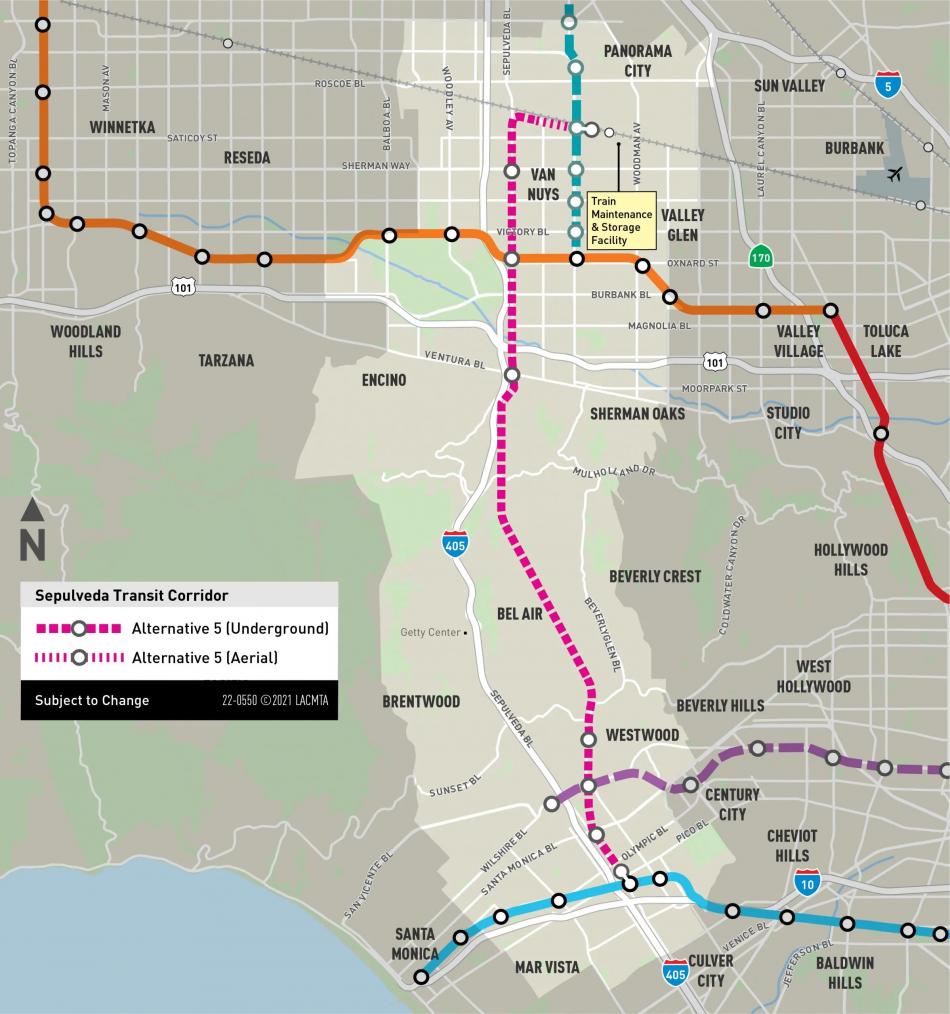 Alternative 5 - heavy rail with underground segment on Sepulveda and an aerial stretch within Metrolink Ventura County Line right-of-wayMetro
Alternative 5 - heavy rail with underground segment on Sepulveda and an aerial stretch within Metrolink Ventura County Line right-of-wayMetro
A roughly 14-mile heavy rail line on the same route as Alternative 4, except that trains would operate below grade along Sepulveda Boulevard in the Valley.
Alternative 6
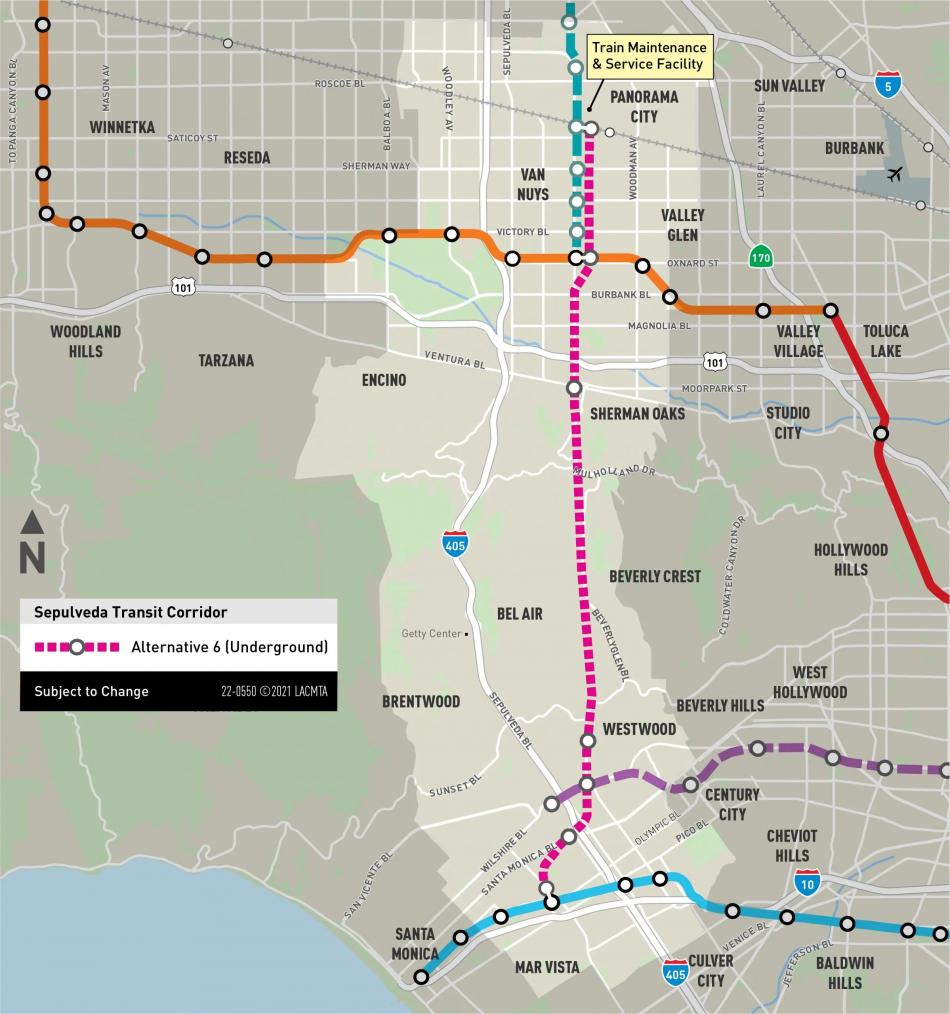 Alternative 6 - fully underground heavy rail between the Van Nuys Metrolink Station and Expo/Bundy StationMetro
Alternative 6 - fully underground heavy rail between the Van Nuys Metrolink Station and Expo/Bundy StationMetro
A 14.6-mile heavy rail subway starting at the Van Nuys Metrolink Station in the north and terminating at Expo/Bundy Station in the south. Unlike the other alternatives, Alternative 6 routes the Sepulveda line down Van Nuys Boulevard, with intermediate stations proposed at the G Line's Van Nuys Station, Ventura Boulevard, UCLA's Gateway Plaza, Wilshire Boulevard, Santa Monica Boulevard (West L.A. Civic Center connection), and Olympic Boulevard (E Line).
Trains could run with maximum lengths of six cars, each with capacity for 133 passengers. Peak-hour headways would be set at four minutes.
Metro is currently weighing two potential public-private partnerships for the Sepulveda Transit Corridor. LA SkyRail Express, a consortium led by BYD, is backing the proposed monorail system, while above while Sepulveda Transit Corridor Partners has proposed the heavy rail alignments seen in Alternatives 4 and 5.
Past ridership forecasts for the Sepulveda rail line have estimated that the project could attract between 122,000 and 137,000 daily riders based on 2042 conditions, with a price tag running in excess of $10.8 billion. Billions in local sales tax revenue is earmarked for the project, with new federal legislation potentially opening up additional funding streams.
Metro has also secured funding via Measure M for a second phase of the Sepulveda Line, which would extend rail service south past the E Line to an eventual terminus at LAX.
To learn more about the project, attend one of Metro's three upcoming virtual meetings:
Tuesday, December 7, 11:30 a.m. to 1:30 p.m.
Registration: https://zoom.us/webinar/register/WN_k9DENFCNQq-CLFneINXb_g
Tuesday, January 11, 2022, 6 p.m. to 8 p.m.
Registration: https://zoom.us/webinar/register/WN_QEfrVMtZRFKYZqPVgz26wg
Saturday, January 22, 2022, 10 a.m. to Noon
Registration: https://zoom.us/webinar/register/WN_QwXtjBgbT8qR7-gO8nghzA
Or provide comments/feedback here: https://bit.ly/SepulvedaCommentForm
- Sepulveda Transit Corridor (Urbanize LA)




